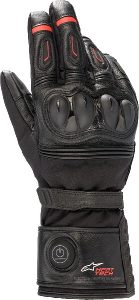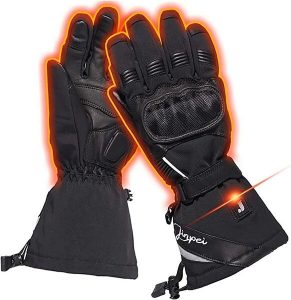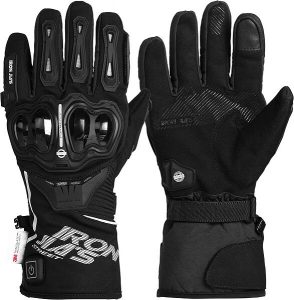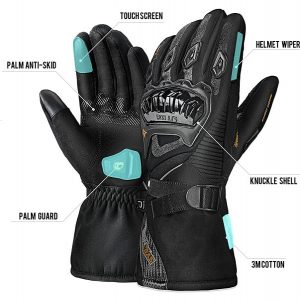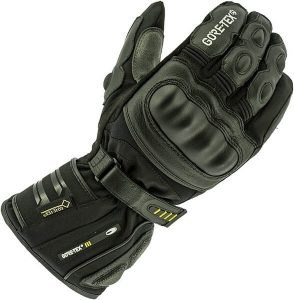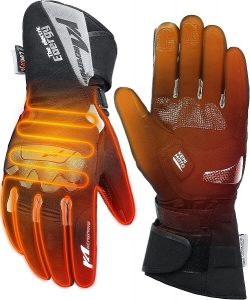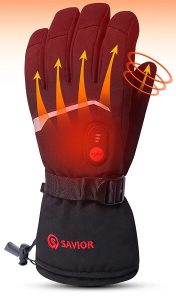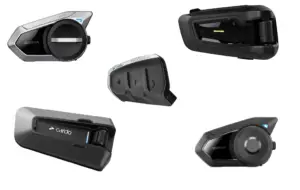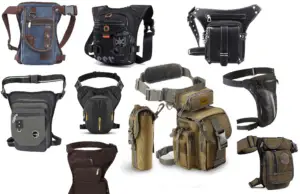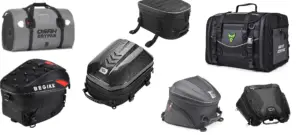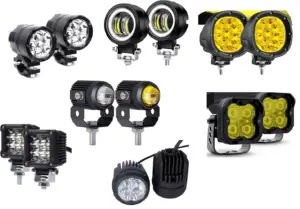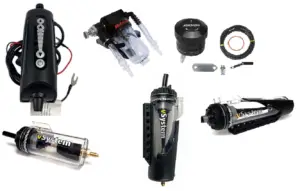Hey there! Riding a motorcycle in cold temperatures is a daunting task for most riders including myself.
The cold wind, along with the reduced insulation on a motorcycle, makes it difficult to keep body temperature at a comfortable level.
This is where heated motorcycle gloves come in.
In this article, I will investigate the various heated gloves offered by manufacturers and determine the essential features and materials for cold-weather riding.
By examining the options available, I will help you make an informed decision when choosing heated gloves for your next ride.
Whether you’re looking to extend your riding season into the winter or want to hit the road earlier this year, heated gloves can make all the difference in making your ride more comfortable and enjoyable.
Contents
7 Motorcycle Winter Gloves Reviewed
Best overall
#1 Alpinestars HT-7 Heat Tech Drystar Gloves
- Insulation Material: Leather, Thermoplastic Polyurethane
- Waterproof: ✅ Yes
- Breathability: ❌ No
- Fit type: Gauntlet
- Comfort Features: Touch screen friendly
- Electric Heating: ✅ 3 heat settings, battery-powered
- CE Level: 1
Unique Features
✅ Alpinestars Heat Tech System, which distributes balanced warmth. The system automatically activates when the hand slides into the glove and has 3 heat settings.
✅ Bluetooth enabled and can be connected to your phone through the dedicated app that allows the temperature setting to be adjusted and displays the battery charge.
✅ Fully CE-certified with rolling finger construction for additional abrasion resistance.
Cheapest gloves
#2 IRON JIA’S AXE-001
- Insulation Material: Nylon, Suede, Cotton
- Waterproof: ✅ Yes
- Breathability: ❌ No
- Fit type: Hook and Loop / Gauntlet
- Comfort Features: Touch screen friendly, visor wipe
- Electric Heating: ❌ No
- CE Level: Not tested
Unique Features
✅ Visor Wipe – a small piece of material on the index finger of a motorcycle glove that is used to wipe away condensation from the visor. The visor wipe is made from a soft, absorbent material that will not scratch the visor.
BEST for money
#3 BORLENI Heated Motorcycle Gloves
- Insulation Material: 3M Thinsulate inner liner
- Waterproof: ❌ No
- Breathability: ✅ Yes
- Fit type: 3/4 Gauntlet
- Comfort Features: Touch screen friendly
- Electric Heating: ✅ 3 heat settings, battery-powered
- CE Level: Not tested
Unique Features
❌ Batteries for electric heating are not included and must be purchased separately. On the plus side, you can buy multiple batteries, charge them at home and swap them during longer rides.
✅ May be plugged into the bike through a 12-volt socket if you don’t want to use batteries. There are small pockets for 2200mah 12V batteries in the wrist section of the gloves.
BEST non-heated gloves
#4 Richa Arctic GTX Gore-TEX Gloves
- Insulation Material: Leather, Textile & Gore-Tex
- Waterproof: ✅ Yes
- Breathability: ✅ Yes (Gore-Tex)
- Fit type: Gauntlet, Hook and loop wrist strap
- Comfort Features: None
- Electric Heating: ❌ No
- CE Level: not tested
Unique Features
✅ Constructed with a combination of leather and textile materials for durability and protection.
✅ Hard plastic knuckle guard with a leather overlay for added protection.
✅ GORE-TEX membrane makes gloves waterproof and breathable simultaneously
Also Good
#5 Kemimoto Heated Motorcycle Gloves
- Insulation Material: Fabric, LIMDRY-tech
- Waterproof: ✅ Yes
- Breathability: ❌ No
- Fit type: Gauntlet, Hook, and loop velcro strap
- Comfort Features: touchscreen friendly, anti-slip palm
- Electric Heating: ✅ 3 heat settings, battery-powered
- CE Level: not tested but have decent protection
Unique Features
✅ Kemimoto gloves have good protection and pliability but the thumb length is short and the fingers are narrow, making them feel tight when riding.
⚠️ Heat of the gloves is not as warm as other heated gloves, but they have decent protection. The design has a single button to turn on/off the gloves and cycle through the temperatures, but it is too easily pressed and can be accidentally powered on. The battery compartment is secured with a hook and loop and is located on the top of the wrist gauntlet which can be annoying.
⚠️ Some users reported that the fingers inside the gloves are squeezed which reduces blood flow.
Also good
#6 SAVIOR Heated Gloves
- Insulation Material: 55% polyester, 20% nylon, 20% polyurethane, 5% elastane
- Waterproof: ✅ Yes
- Breathability: ❌ No
- Fit type: Gauntlet
- Comfort Features: touchscreen-friendly
- Electric Heating: ✅ 3 heat settings, battery-powered
- CE Level: Not tested / No Motorcycle Protection
Unique Features
⚠️ Feel bulky and make operating the clutch and other motorcycle controls including the indicator switch more difficult compared to other gloves.
⚠️ No knuckle guard protection and the material is not durable in case of impact, abrasion, and penetration.
Runner Up
#7 JINPEI Heated Gloves
- Insulation Material: 40% lambskin and 60% polyester
- Waterproof: ✅ Yes
- Breathability: ❌ No
- Fit type: Gauntlet
- Comfort Features: touchscreen-friendly, windshield viper
- Electric Heating: ✅ 3 heat settings, battery-powered
- CE Level: Not tested
Unique Features
✅ Made of a combination of lambskin and polyester, making them windproof and water-resistant.
✅ Infrared fiber heating elements that cover the whole fingers to promote blood circulation and relieve hand pain symptoms.
✅ The gloves also have carbon fiber knuckle guards for added protection and touch sensors on the index finger and thumb for use with smart devices.
Cold Weather Motorcycle Gloves Buying Guide
When buying cold-weather motorcycle gloves, consider the following factors:
- Insulation: Look for gloves that are insulated with materials such as Thinsulate or Gore-Tex, which will keep your hands warm in cold temperatures.
- Waterproofing: Make sure the gloves are waterproof to keep your hands dry in wet conditions.
- Breathability: gloves with breathable lining prevent hands from overheating and sweating.
- Durability: gloves made with durable materials will last many years and withstand wear and tear from riding.
- Fit and Comfort: gloves should fit well and be comfortable to use motorcycle controls and handlebar switches.
- Additional protection: Some cold-weather gloves come with extra protection for knuckles and wrists.
- Heating option: gloves with internal heating elements are most comfortable but cost more and weigh more.
- Brand reputation: Consider buying from a reputable brand known for producing quality motorcycle gear.
Insulation and Wind Protection
When it comes to insulation for motorcycle gloves, there are a few common materials used including Thinsulate, Gore-Tex, Primaloft, Down, and Fleece. It’s important to note that if you ride in cold conditions, consider gloves specifically designed for wind protection, such as gloves with a windproof membrane or a windproof and waterproof membrane.
Thinsulate: Designed to trap heat inside the gloves and keep hands warm. However, it may not provide as much protection against a strong wind as some other materials.
Gore-Tex: Designed to be waterproof and breathable, which can help to keep your hands warm in windy conditions. However, it may not provide as much insulation as some other materials.
Primaloft: This material is designed to trap heat inside the gloves and keep your hands warm. It’s also water-resistant and can retain its insulating properties even when wet. Provides decent wind resistance.
Down: Down is an excellent insulator and can provide great warmth, but it may not provide much wind resistance.
Fleece: Fleece is a synthetic insulation that is lightweight, breathable, and can be very warm, but also may not provide much wind resistance.
Polyester: A synthetic fabric that is water-resistant and wind-resistant, but it is not breathable.
Nylon: A synthetic fabric that is water-resistant and wind-resistant, but it is not breathable.
Polyurethane: A synthetic material that is water-resistant and wind-resistant, but not breathable.
Elastane: A synthetic fabric that is stretchy and flexible, but it is not waterproof, windproof, or breathable.
Thinsulate: Thinsulate is an insulation material that is designed to trap air and retain heat, but is not waterproof, windproof, or breathable.
Thermoplastic Polyurethane: Flexible and durable, but is not waterproof, windproof, or breathable.
LIMDRY-tech: It’s a technology that allows the material to be waterproof, breathable, and windproof.
Lambskin: A natural material that is soft and durable, but does not provide waterproof, windproof, or breathable properties.
Waterproofness and Breathability
Waterproof motorcycle gloves typically feature a waterproof and breathable membrane, such as Gore-Tex or eVent, that allows perspiration to escape while preventing water from entering the glove. Other features include adjustable straps for a secure fit.
Waterproof motorcycle gloves materials include:
- Leather: Leather is a popular choice for motorcycle gloves because it is durable, abrasion-resistant, and offers good protection in the event of a crash. However, leather is expensive and in not as breathable as other materials. To make leather gloves waterproof, manufacturers apply a water-repellent coating or sealant.
- Textile: Textile gloves are made from synthetic materials such as nylon or polyester. They are lightweight and breathable but don’t provide as much protection as leather gloves. To make textile gloves waterproof, manufacturers use a breathable, waterproof membrane such as Gore-Tex or eVent.
- Synthetic materials: Some manufacturers use synthetic materials like rubber and neoprene to make motorcycle gloves waterproof. These materials are less expensive than leather or textile gloves and provide a good level of waterproofing.
It is important to note that the materials used to make the gloves waterproof should be breathable as well to avoid any moisture from perspiration build-up inside the gloves which can cause discomfort and can also lead to hypothermia in cold conditions.
Durability
Generally, gloves made from high-quality materials such as leather or abrasion-resistant fabrics will last longer than those made from cheaper materials. Proper care, such as cleaning and conditioning the leather, can also help extend the life of the gloves.
Fit and Comfort of use
Proper fit is essential for safety, as gloves that are too loose or too tight can impede movement and reduce the effectiveness of the protective features.
Comfort is also important for long-distance riding, as gloves that are uncomfortable can cause hand fatigue and discomfort. Look for gloves that are made from breathable materials, have padded palms and fingers, and have a flexible design that allows for the natural movement of the hand.
Some gloves come with extra features such as ventilation and waterproofing which enhance the comfort of use.
Additionally, you can also look for gloves that have adjustable straps or closures that can be adjusted for a snug fit. This will help to keep the gloves securely in place and prevent them from slipping or bunching up while you’re riding.
Cut – Always Choose the Gauntlet type for Cold Weather
CUT of the motorcycle gloves refers to the design and shape of the gloves. There are several different cut styles of motorcycle gloves, including:
- Short Cuff: These gloves are the most common type and have a shorter cuff that covers the wrist but not the lower arm.
- Gauntlet: These gloves have a longer cuff that covers the wrist and extends up the lower arm for added protection.
- Convertible: These gloves can be converted from full-fingered to fingerless by removing the finger sections.
- 3/4: These gloves are a hybrid between the short cuff and gauntlet gloves, which covers the wrist and about 3/4 of the lower arm.
Shorter gloves are great for hot weather while longer gloves provide better protection in colder weather.
It’s also important to consider the level of protection required for your riding. Gauntlet gloves provide more protection to your wrists and lower arm than shorter gloves.
Grippy Palms
Grippy palms refer to a textured and reinforced surface on the palms to provide a better grip on the handlebars. Specifically, it prevents throttle slip and allows you to simply rest your hand on the throttle to keep it in a fixed position. This reduces hand fatigue during long road stretches.
touchscreen compatibility
The ability to operate your smartphone touchscreen and GPS without taking off motorcycle gloves is very convenient if you need to quickly check navigation on the go or while standing at the red light.
This is achieved through the use of special touchscreen-sensitive materials or conductive fibers in the fingertips of the gloves.
Additional protection
Armor
Reinforced knuckle guards, reinforced fingertips, or padded palms, are designed to provide extra protection for the hands in the event of an accident or fall, and can also provide additional warmth and comfort for the rider’s hands.
CE level
CE, which stands for “Conformité Européene,” is a label indicating that motorcycle gloves have met certain safety and performance standards set by the European Union.
CE-rated motorcycle gloves are assigned a protection level of 1, 2, or 3, with level 1 providing the least amount of protection and level 3 providing the most. The level of protection is determined by a series of tests that measure the gloves’ ability to protect against impact, abrasion, and penetration.
When looking for motorcycle gloves it is highly recommended to look for CE-rated gloves as they have passed EU safety standard tests.
Electric Heating
Electric heating in motorcycle gloves works by using a small battery-powered heating element that is integrated into the glove. The heating element is made of a thin, flexible material that is incorporated into the glove’s lining. When the gloves are turned on, the heating element generates heat, which is then distributed throughout the glove to warm the wearer’s hands. The heat can be controlled using a remote or built-in control, allowing you to adjust the temperature to your liking. The gloves are typically powered by rechargeable batteries, which can be recharged using a USB cable or other charging method.
Brand reputation
When choosing motorcycle gloves, it’s crucial to consider the brand reputation. A reputable brand has likely accumulated decades of knowledge and experience in designing, launching, and testing its products, ensuring that each new product is slightly better than the last. This is especially important for safety products like motorcycle gear, where a mistake in the design or manufacturing could cost you your health or even your life.
For example, a tear in a cheap Chinese glove could result in a lost finger, while a reputable brand is more likely to produce durable, high-quality gloves that have been thoroughly tested and reviewed by customers. This gives the customer peace of mind, knowing they are purchasing a product that has been proven to be reliable and safe. In short, investing in a reputable brand of motorcycle gloves can be the difference between a safe and enjoyable ride, or a dangerous one.
